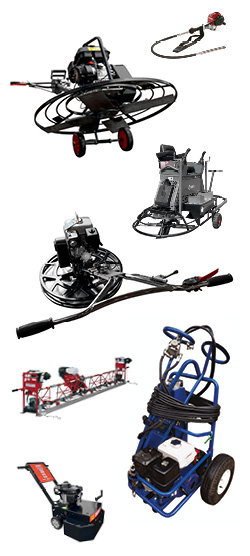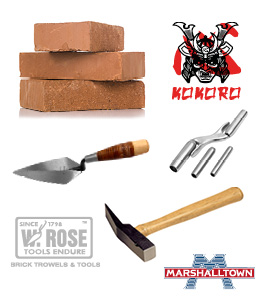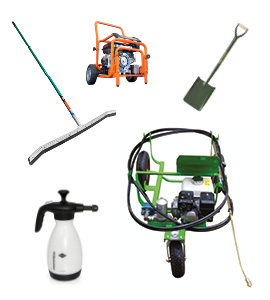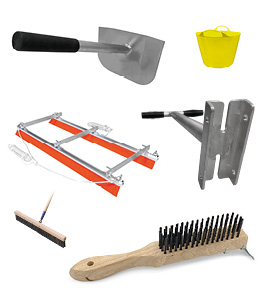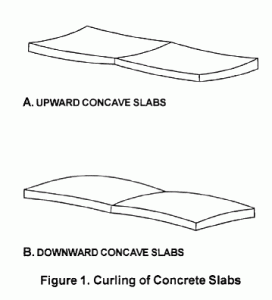 Curling is the distortion of a slab into a curvedshape by upward or downward bending of the edges. This distortion canlift the edges of the slab from the base leaving an unsupported edge orcorner which can crack when heavy loads are applied. Sometimes, curling is evident at any early age. In other cases, slabs may curl over an extended period.
Why do Concrete Slabs Curl? Typically, upward curling of the edges of a slab iscaused by shrinkage or contraction of the top relative to the bottom.When one surface of the slag changes size more than the other, the slab will warp its edges in the direction of relative shortening. This curling is most noticeable at the sides and corners.
Changes in slab dimensions which lead to curlingare most often related to moisture and temperature gradients in theslab. One primary characteristic of concrete which affects curling isdrying shrinkage. The most common occurrence of curling is when the toppart of the slab dries and shrinks with respect to the bottom.
The slab edges curl upward (Figure 1A). Immediate curling of a slab is most likely related to poor curing and rapidsurface drying; and anything that increases drying shrinkage, such as an admixture, will tend to increase curling.
In slabs, bleeding and poor curing both tend to produce surface concrete with higher drying shrinkage potential thanthe concrete in the bottom of the slab. Bleeding is accentuated inslabs on polyethylene or topping mixtures placed on concrete slabs; and shrinkage differences from top to bottom in these cases are larger thanfor slabs on an absorptive subgrade.
Thin slabs and long joint spacing tend to increase curling. For this reason, thin unbonded toppings need to have a fairly close joint spacing.
In industrial floors, close joint spacing may beundesirable because of the increased number of joints and increased joint maintenance problems. However, this must be balanced against the probability of intermediate random cracks and increased curling at thejoints. The other factor that can cause curling is temperature differences between the top and bottom of the slab. The top part of the slab exposed to the sun will expand relative to the cooler bottomcausing a downward curling of the edges (Figure 1B). Alternately,during a cold night when the top cools and contracts with respect to awarmer subgrade, the curling due to this temperature differential will add to the upward curling caused by moisture differentials. How to Minimize Slab Curling The primary factors controlling dimensional changesof concrete which lead to curling are drying shrinkage, construction practices, moist or wet subgrades, and day-might temperature cycles. The following practices will help to minimize the potential for curling:
Curling is the distortion of a slab into a curvedshape by upward or downward bending of the edges. This distortion canlift the edges of the slab from the base leaving an unsupported edge orcorner which can crack when heavy loads are applied. Sometimes, curling is evident at any early age. In other cases, slabs may curl over an extended period.
Why do Concrete Slabs Curl? Typically, upward curling of the edges of a slab iscaused by shrinkage or contraction of the top relative to the bottom.When one surface of the slag changes size more than the other, the slab will warp its edges in the direction of relative shortening. This curling is most noticeable at the sides and corners.
Changes in slab dimensions which lead to curlingare most often related to moisture and temperature gradients in theslab. One primary characteristic of concrete which affects curling isdrying shrinkage. The most common occurrence of curling is when the toppart of the slab dries and shrinks with respect to the bottom.
The slab edges curl upward (Figure 1A). Immediate curling of a slab is most likely related to poor curing and rapidsurface drying; and anything that increases drying shrinkage, such as an admixture, will tend to increase curling.
In slabs, bleeding and poor curing both tend to produce surface concrete with higher drying shrinkage potential thanthe concrete in the bottom of the slab. Bleeding is accentuated inslabs on polyethylene or topping mixtures placed on concrete slabs; and shrinkage differences from top to bottom in these cases are larger thanfor slabs on an absorptive subgrade.
Thin slabs and long joint spacing tend to increase curling. For this reason, thin unbonded toppings need to have a fairly close joint spacing.
In industrial floors, close joint spacing may beundesirable because of the increased number of joints and increased joint maintenance problems. However, this must be balanced against the probability of intermediate random cracks and increased curling at thejoints. The other factor that can cause curling is temperature differences between the top and bottom of the slab. The top part of the slab exposed to the sun will expand relative to the cooler bottomcausing a downward curling of the edges (Figure 1B). Alternately,during a cold night when the top cools and contracts with respect to awarmer subgrade, the curling due to this temperature differential will add to the upward curling caused by moisture differentials. How to Minimize Slab Curling The primary factors controlling dimensional changesof concrete which lead to curling are drying shrinkage, construction practices, moist or wet subgrades, and day-might temperature cycles. The following practices will help to minimize the potential for curling:
- Use the lowest practical slump and avoid adding retempering water, particularly in hot weather.
- Use the larges practical maximum size aggregate and/or thehighest practical coarse aggregate content to minimize dryingshrinkage.
- Take precautions to avoid excessive bleeding. Use a damp, butabsorptive, subgrade so that all the bleed water is not forced to thetop of the slab.
- Avoid using polyethylene vapor barriers unless covered with at least two inches of damp sand.
- Avoid a higher than necessary cement content if the subgradeis wet in service. Dense, impermeable concrete will produce larger topto bottom moisture differentials and curl more. Use of fly ash ispreferable to very high cement content, and consideration should begiven to specifying strength at 56 to 90 days.
- Cure the concrete thoroughly, including joints and edges. Ifmembrane curing compounds are used, apply at twice the recommended ratein two applications at right angles to each other.
- For floor areas where curling tends to be a problem, cure theconcrete with a heavy wax floor sealing compound of the type used onterrazzo. (Note: Tile adhesives will not stick to these materials.)
- Use a joint spacing in feet equal to two times the slabthickness in inches (PCA recommendation for maximum size aggregate lessthan ¾ inch).
- For thin toppings, clean the base slab to ensure bond andconsider use of studs and wire around the edges and particularly in theslab corners.
- Use a thicker slab.
- The use of properly designed and placed slab reinforcement may help reduce curling.
References
- Cement and Concrete Terminology, ACI SP-19, American ConcreteInstitute (ACI), P.O. Box 19150 Redford Station, Detroit, Michigan48219.
- Guide for Concrete Floor and Slab Construction (ACI 302), ACI Manual of Concrete Practice, Part 2.
- “Shrinkage and Curling of Slabs on Grade, Part 11 Warping andCurling,” R.F. Ytterberg, ACI Concrete International May 1987, pp.54-61.
- “Drying Shrinkage of Concrete,” R.C. Meininger, NRMCAEngineering Report No.l RD3 ( A Summary of Joint Research LaboratorySeries), June 1966, 22 pp.
- NRMCA “Concrete in Practice” (CIP) Series.
- “Slabs on Grade,” ACI Concrete Craftsman Series.
- Transportation Research Record 1207, Pavement Design, National Research Council, Washington, D.C., 1988, p. 44.
- “Design and Control of Concrete Mixtures,” Portland Cement Association, Thirteenth Edition, 1988.

